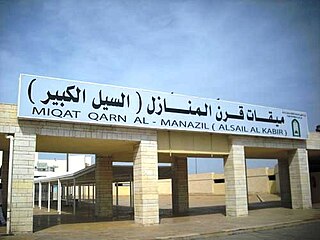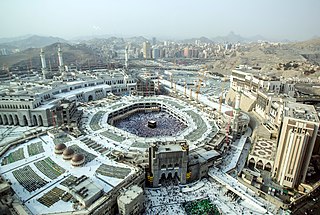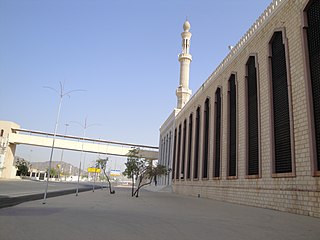Uranah is a location in Saudi Arabia. The Expedition of Abdullah Ibn Unais took place here in the year 625. [1] Muhammad sent Abdullah ibn Unais to kill Khalid bin Sufyan, because there were reports he considered an attack on Madinah and that he was inciting the people on Nakhla or Uranah to fight Muslims. [1]
During Hajj, Muhamamd stopped at Uranah and gave a Khutbah (speech). [2]

Mecca is the capital of Mecca Province in the Hejaz region of western Saudi Arabia and the holiest city in Islam. It is 70 km (43 mi) inland from Jeddah on the Red Sea, in a narrow valley 277 m (909 ft) above sea level. Its last recorded population was 2,385,509 in 2022. Its metropolitan population in 2022 is 2.4 million, making it the third-most populated city in Saudi Arabia after Riyadh and Jeddah. Around 44.5% of the population are Saudi citizens and around 55.5% are foreigners from other Muslim countries. Pilgrims more than triple the population number every year during the Ḥajj pilgrimage, observed in the twelfth Hijri month of Dhūl-Ḥijjah. With over 10.8 million international visitors in 2023, Mecca was one of the 10 most visited cities in the world.

Year 632 (DCXXXII) was a leap year starting on Wednesday of the Julian calendar. The denomination 632 for this year has been used since the early medieval period, when the Anno Domini calendar era became the prevalent method in Europe for naming years.

The Hejaz is a region that includes the majority of the west coast of Saudi Arabia, covering the cities of Mecca, Medina, Jeddah, Tabuk, Yanbu, Taif and Baljurashi. It is thus known as the Western Province, and it is bordered in the west by the Red Sea, in the north by Jordan, in the east by the Najd, and in the south by the Region of 'Asir. Its largest city is Jeddah, which is the second-largest city in Saudi Arabia, with Mecca and Medina, the holiest Muslim sites and respectively,the fourth- and fifth-largest cities in the country.

Taif is a city and governorate in the Province of Makkah in Saudi Arabia. Located at an elevation of 1,879 m (6,165 ft) in the slopes of the Hijaz Mountains, which themselves are part of the Sarat Mountains, the city has a population of 563,282 people in 2022, making it one of the most populous cities in the kingdom.

The House of Saud is the ruling royal family of Saudi Arabia. It is composed of the descendants of Muhammad bin Saud, founder of the Emirate of Diriyah, known as the First Saudi state (1727–1818), and his brothers, though the ruling faction of the family is primarily led by the descendants of Abdulaziz bin Abdul Rahman, the modern founder of Saudi Arabia. It forms a subtribe of the larger prominent ancient Banu Hanifa tribe of Arabia, from which well known 7th century Arabian theologist Maslama ibn Ḥabīb originates. The most influential position of the royal family is the King of Saudi Arabia, an absolute monarch. The family in total is estimated to comprise 15,000 members; however, the majority of power, influence and wealth is possessed by a group of about 2,000 of them. Some estimates of the royal family's wealth measure their net worth at $1.4 trillion.This figure includes the market capitalization of Saudi Aramco, the state oil and gas company, and its vast assets in fossil fuel reserves, making them the wealthiest family in the world and the wealthiest in recorded history.

The Emirate of Diriyah, also known as the First Saudi State, was established in February 1727. In 1744, the emir of a Najdi town called Diriyah, Muhammad bin Saud, and the religious leader Muhammad ibn Abd al-Wahhab formed an alliance to found a socio-religious reform movement to unify the many states of the Arabian Peninsula.

The Rashidi dynasty, also called Al Rashid or the House of Rashid, was a historic Arabian House or dynasty that existed in the Arabian Peninsula between 1836 and 1921. Its members were rulers of the Emirate of Ha'il and the most formidable enemies of the House of Saud, rulers of the Emirate of Nejd. They were centered in Ha'il, a city in northern Najd that derived its wealth from being on the route of the Hajj pilgrimage to Mecca, and was also a commercial center. The rulers of Ha'il were the sons of Abdullah bin Rashid, founder of the dynasty.

The Umrah is an Islamic pilgrimage to Mecca, the holiest city for Muslims, located in the Hejazi region of Saudi Arabia. It can be undertaken at any time of the year, in contrast to the Ḥajj, which has specific dates according to the Islamic lunar calendar.

The Emirate of Nejd or Imamate of Nejd was the Second Saudi State, existing between 1824 and 1891 in Nejd, the regions of Riyadh and Ha'il of what is now Saudi Arabia. Saudi rule was restored to central and eastern Arabia after the Emirate of Diriyah, the First Saudi State, having previously been brought down by the Ottoman Empire's Egypt Eyalet in the Ottoman–Wahhabi War (1811–1818).
The Sulaymani branch of Tayyibi Isma'ilism is an Islamic community, of which around 70,000 members reside in Yemen, while a few thousand Sulaymani Bohras can be found in India. The Sulaymanis are sometimes headed by a Da'i al-Mutlaq from the Makrami family.

Rabigh is a city and governorate in the Province of Makkah of the Kingdom of Saudi Arabia, situated on the coast of the Red Sea, around 208 km (129 mi) northwest of Mecca in the historic Hejazi region. The city had an estimated population of 180,352 in 2014 and is situated at an elevation of 13 m (43 ft) above sea level, close to the border with the Madinah Province. The city dates back to the era before the advent of Islam in the 7th century C.E., and up to the 17th century, was known as Al-Juhfah, or Al-Johfah.

As-Sayl Al-Kabīr is a village in Makkah Region, western Saudi Arabia, which is located some distance from the city of Taif. Abdullah ibn Abbas narrated that his cousin, the Islamic Prophet Muhammad, had fixed Qarn al-Manāzil as the miqat for the people of Najd. It has also been used as a miqat by people coming from places like Oman, the U.A.E., Pakistan, Malaysia and Australia.

The Emirate of Jabal Shammar, also known as the Emirate of Haʾil or the Rashidi Emirate, was a state in the northern part of the Arabian Peninsula, including Najd, existing from the mid-nineteenth century to 1921. Jabal Shammar in English is translated as the "Mountain of the Shammar". Jabal Shammar's capital was Ha'il. It was led by the monarchy of the Rashidi dynasty. It included parts of modern-day Saudi Arabia, Iraq, and Jordan.

Masjid al-Haram, also known as the Sacred Mosque or the Great Mosque of Mecca, is considered to be the most significant mosque in Islam. It encloses the vicinity of the Kaaba in Mecca, in the Mecca Province of Saudi Arabia. It is among the pilgrimage sites associated with the Hajj, which every Muslim must perform at least once in their lives if able. It is also the main site for the performance of ʿUmrah, the lesser pilgrimage that can be undertaken any time of the year. The rites of both pilgrimages include circumambulating the Kaaba within the mosque. The Great Mosque includes other important significant sites, such as the Black Stone, the Zamzam Well, Maqam Ibrahim, and the hills of Safa and Marwa.
Banu Lahyan were an Arab pagan tribe during the time of Muhammad and were involved in several military conflicts with him. The first was in 625 during the Expedition of Abdullah Ibn Unais, where Muhammad sent Abdullah ibn Unais to kill Khaled bin Sufyan Al-Hathali, who was the chief of the tribe. Muhammad alleged that he was planning to attack Madinah and incite the people of Nakhla and Uranah to attack him. Therefore, he sent Abdullah ibn Unais to assassinate him in 625 during the Expedition of Abdullah Ibn Unais. This was followed by the Invasion of Banu Lahyan in September 627 when Muhammad ordered his followers to attack the Banu Lahyan tribe to get revenge for the killing of 10 Muslims in the Expedition of Al Raji
Abdullah ibn Unais was a companion (Sahaba) of the Islamic prophet Muhammad. He participated in several military campaigns ordered by Muhammad. The first was to kill Khaled bin Sufyan Al-Hathali who belonged to the Banu Lahyan tribe. Muhammad said that he was planning on attacking Madinah and inciting the people of Nakhla and Uranah to attack him. Therefore he sent Abdullah ibn Unais to assassinate him in 625 during the Expedition of Abdullah Ibn Unais.

Al-Baqi cemetery, the oldest and one of the two most important Islamic graveyards located in Medina, in current-day Saudi Arabia, was demolished in 1806 and, following reconstruction in the mid-19th century, was destroyed again in 1925 or 1926. An alliance of the House of Saud and the followers of the Wahhabi movement known as the Emirate of Diriyah carried out the first demolition. The Sultanate of Nejd, also ruled by the House of Saud and followers of Wahhabism, carried out the second. In both cases, the actors were motivated by the Wahhabi interpretation of Islam, which prohibits the building of monuments on graves.

Muhammad bin Abdullah Al Rashid was one of the Emirs of Jabal Shammar and is known for his defeat of the Saudi State in the battle of Mulayda which ceased to exist for a second time in 1891. His reign lasted from 1869 to 1897, and he was the most influential ruler of the Emirate of Jabal Shammar for which he is called Muhammad the Great.

Masjid an-Namirah or Masjid Nimrah is a mosque in Wadi Uranah near Mecca in the Hejazi region of Saudi Arabia. It is believed to be where the Islamic prophet Muhammad stayed before delivering his last sermon in 'Arafat. It is one of the most important landmarks during the Hajj, as it is where the khutbahs are delivered to pilgrims during the Day of Arafah during the Dhuhr and Asr prayers. It is located near Mount Arafat.